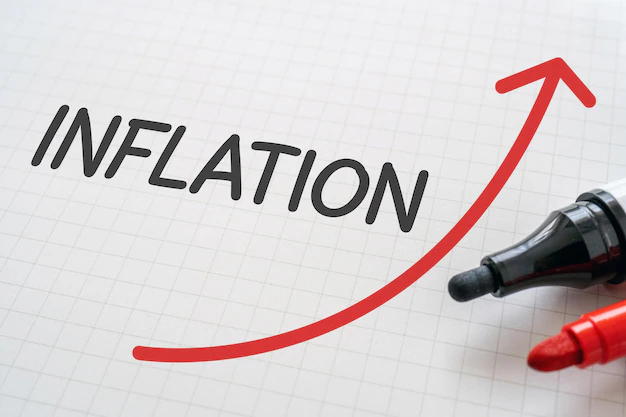Table of Contents
Introduction
Inflation is an economic term that describes the general rise in prices of goods and services over time. Simply put, this means that with inflation, each unit of currency buys less than before. This decline in purchasing power affects consumers, businesses, and the overall economy. Inflation can result from a variety of factors, including increased demand, rising production costs, changes in the value of currency, and monetary policy. Understanding inflation is critical for individuals, businesses, and policymakers because it affects financial planning, investment, and economic stability.
Reasons for Inflation

Economic boom and increased demand↴
- An economic boom, characterized by strong growth, leads to increased consumer spending.
- Rising demand for goods and services during an economic boom puts upward pressure on prices.
- Businesses respond to increased demand by raising prices to maximize profit.
Cost inflation from rising raw material prices↴
- Cost inflation is the result of rising prices of raw materials and production inputs.
- Businesses facing higher production costs may raise the prices of their final products to maintain profitability.
- External factors such as global market trends, weather or geopolitical issues can contribute to the increase in commodity prices.
Wage inflation pressure with salary increases↴
- When wages and salaries rise, businesses can adjust product prices to cover higher labor costs.
- Higher wages for workers contribute to increased production costs and force businesses to pass on additional costs to consumers.
- Low unemployment can also put upward pressure on wages as companies compete for skilled workers.
Currency debasement and excessive money printing↴
- Currency depreciation occurs when a national currency loses value compared to other currencies.
- Excessive money printing by governments can lead to an excess supply of a currency, causing its value to decline.
- A weakened currency contributes to higher import costs and affects the overall price level in the domestic economy.
Extreme Cases of Inflation
The mention of hyperinflation in countries like Venezuela and Zimbabwe points to extreme cases where inflation has gotten out of control. In these cases, the consequences for the value of the currency were dire. Hyperinflation can lead to a rapid devaluation of a national currency, causing a loss of purchasing power at an alarming rate. Citizens in the affected countries experienced a sharp increase in the prices of basic goods and services, which reduced the real value of their incomes and savings. In extreme cases, hyperinflation can result in the issuance of high denomination notes such as million or billion notes, further underscoring the serious erosion of the currency’s value. The economic and social consequences of hyperinflation are profound and affect the daily lives and financial stability of the population.
During COVID Scenario and Cash Transfers
The global drop in inflation during the lockdown stems from reduced demand as economic activity has slowed. Faced with an economic downturn, some countries are considering cash transfers as a measure to counter the resulting financial problems. There is a debate over whether these remittances would contribute to inflation. The reason for this discussion is that injecting more money into the economy could stimulate demand and potentially raise prices. However, views differ on the extent to which remittances could affect headline inflation, given the broader economic context and the effectiveness of such measures in addressing the unique challenges posed by economic crises.
Optimal Inflation Rates
Developed countries typically set a target inflation rate of around 2% to maintain price stability and promote economic growth. In contrast, India has set a slightly higher inflation target of 4% with a margin of ±2%. This suggests that India’s monetary policy allows for some flexibility in managing the inflation rate between 2% and 6%. Both sets of targets reflect the delicate balance that policymakers are trying to strike between controlling inflation and promoting sustainable economic development in their respective regions.
Controlling Inflation
The central bank plays a key role in controlling inflation primarily through interest rate adjustments. By raising or lowering interest rates, the central bank affects borrowing costs, affects consumer spending and business investment, and thereby controls overall demand in the economy. In addition to interest rates, other methods used to control inflation include careful management of the money supply. This includes the ability to print more money, impose taxes, and adjust government spending. These diverse instruments provide policymakers with a variety of strategies to address inflationary pressures and maintain economic stability.

Personal Consequences of Inflation
The impact of inflation on personal savings is significant, leading to a reduction in the value of money over time. As prices rise, the purchasing power of saved money decreases, which affects the real value of savings. To counter the erosion of wealth caused by inflation, individuals often invest in assets such as gold. Gold, known for its historical resistance to inflation, serves as collateral to preserve and potentially increase the value of savings. By investing in tangible assets, individuals try to mitigate the effects of inflation and protect the purchasing power of their wealth over the long term.
Conclusion

Emphasizing the importance of understanding inflation lies in recognizing its far-reaching economic and personal consequences. Inflation not only affects the overall cost of living and business operations, but also affects personal savings, investments and purchasing power. Moreover, managing inflation is a complex task, as policymakers must navigate the delicate balance between price stability and economic growth. The complex relationship between inflation and economic dynamics requires different strategies to ensure sustainable development while mitigating the adverse effects of rising prices on both national economies and individual financial well-being.
